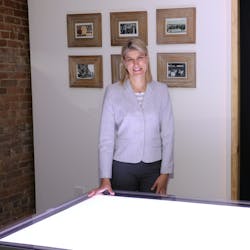The Lighting Research Center (LRC) at Rensselaer Polytechnic Institute (RPI) has announced results from a study of the impact of lighting interventions based on LED sources with Alzheimer’s patients in elderly care facilities. The solid-state lighting (SSL) therapy resulted in improved sleep patterns, reduced symptoms of depression, and lessened signs of agitation. Meanwhile, the research lab also announced a new 3-D printing research project focused on additive manufacturing of LED luminaires working in partnership with Eaton.
Alzheimer’s study
LRC director and RPI professor Dr. Mariana Figueiro led the Alzheimer’s research project, full results of which have been published in the Journal of Clinical Sleep Medicine. The scope included a 14-week clinical trial working with 46 patients diagnosed with Alzheimer’s disease and related dementia (ADRD) that were living in long-term care facilities. The National Institute on Aging (NIA) funded the project.
The premise of the study centered on the fact that elderly residents of care facilities often get little exposure to outdoor lighting, are exposed to relatively dim indoor lighting during the day, and are exposed to levels that are likely too bright for healthy circadian entrainment during the evening hours. Whereas typical adults might be exposed to 1000 or even 10,000 lx outdoors during the day, patients in care centers typically have 100-lx exposure during the day.
The goal of the lighting intervention was not to directly impact ADRD. But the LRC said the challenges caregivers face with such patients are often due more to lack of sleep and agitation than the actual disease. The right light exposure could presumably improve the quality of life for the patients and enable caregivers to be more efficient with the patients.
The researchers used wrist-worn actigraph devices to document gross motor activity. And the team used standardized techniques to qualitatively characterize sleep quality, mood, and behavior. The patients receiving the active intervention were documented as enjoying better sleep and more-content days.
“When delivered appropriately using CS and different delivery modes, and accurately measured using calibrated personal light meter devices, a lighting intervention tailored to maximally entrain the circadian system will significantly improve sleep quality, depressive symptoms, and agitation behavior in patients with ADRD,” said Figueiro. “It is important to use, deliver, and measure the right lighting to see the positive effects.”
You can learn more about CS and other metrics in the lighting for health area at our upcoming Strategies in Light conference. The conference program is packed with compelling sessions and on Wednesday, Feb. 12 at 1:30 PM, Figueiro’s colleague Dr. Mark Rea will lead a panel titled “Standards for Circadian Lighting.” Renowned researcher Dr. Martin Moore-Ede will also participate.
You can read the full article on the ADRD study on the Journal of Clinical Sleep Medicine website.
3-D printing
Moving to a vastly different topic, the LRC is just embarking on a new round of 3-D printing work based on funding from the US Department of Energy (DOE) and its SSL R&D Funding Opportunity program. The project will run for two years, and will focus on the potential of additive manufacturing in reducing the cost of some of the more-expensive subsystems of a typical LED-based luminaire.
At the LRC, director of research Dr. Nadarajah Narendran will lead the research. He has long experience with many aspects of SSL and has worked on 3-D printing research for several years. Narendran led a panel at Strategies in Light last year focused on 3-D printing and SSL, and has another planned for 2020 at 3:45 PM on Feb. 12 with participants from GE Additive, Henkel, Stratasys, and Protolabs.
[Editor’s note: When we originally wrote and posted this news story, we had not been able to confirm whether the 3-D-centric LRC partnership would be with Eaton or with Cooper Lighting, leading us to write the paragraph that remains below. We have since learned from the LRC that in fact the DOE funding was to the LRC and Eaton, and in fact the DOE announcement states that Eaton is the “Lead Performer” on the project.]
When we posted this article, there had been no announcement from Eaton on this R&D project. We’d suspect that lack of announcement is due to the fact that Eaton is selling its Cooper Lighting division to Signify. Cooper is slated to remain a branded business unit under Signify. Most likely, this research will proceed with Cooper working in conjunction with the LRC and not Cooper’s former parent Eaton.
*Updated Dec. 19, 2019 2:45 PM for company participant clarification.






